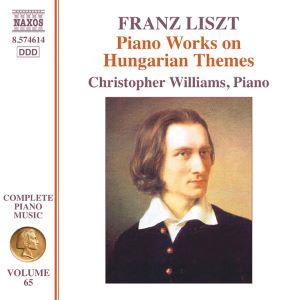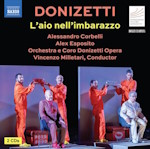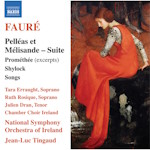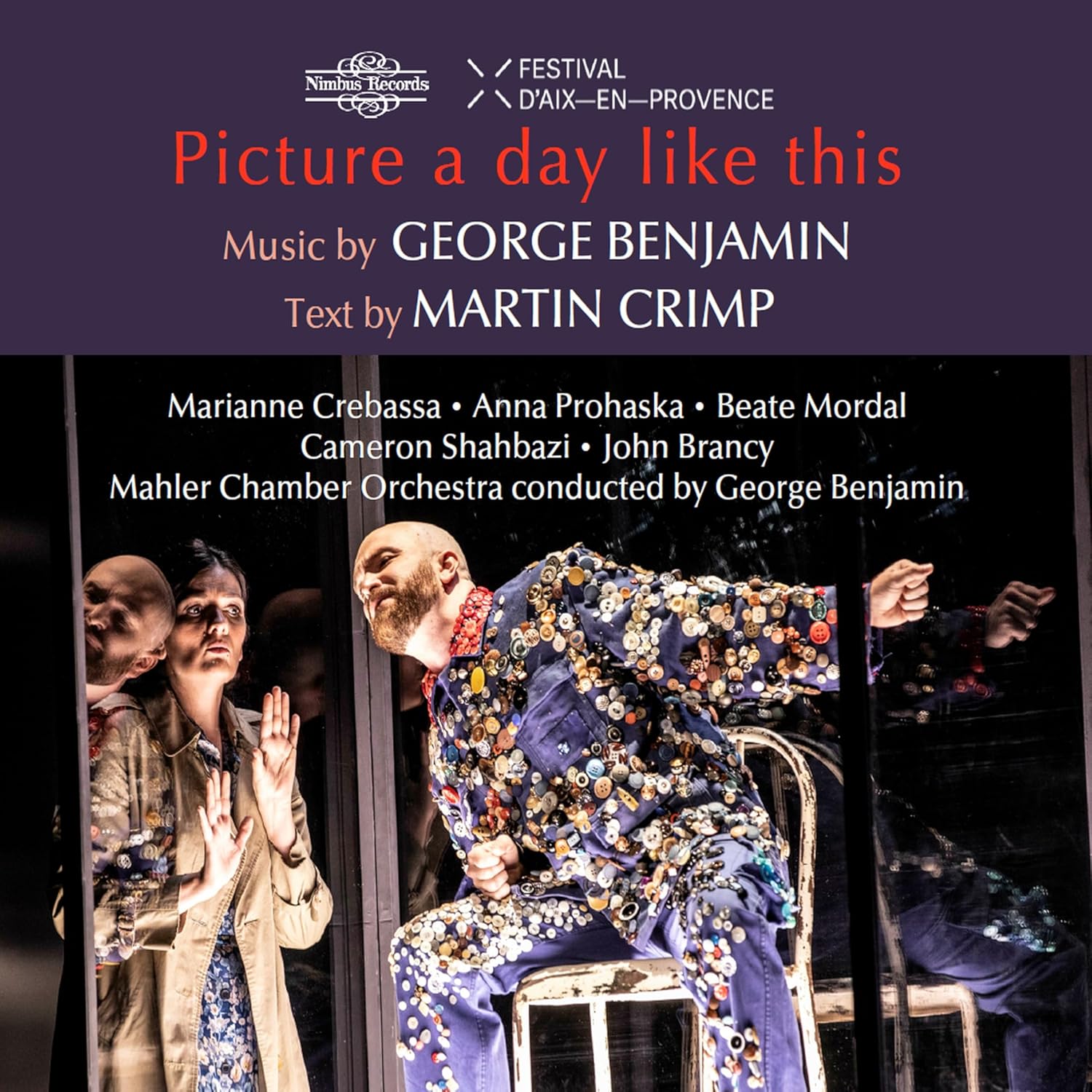
Franz Liszt (1811-1886)
Complete Piano Music Vol.65: Piano Works on Hungarian Themes
Rákóczi March, nach der Orchesterbearbeitung, S244a
Magyar dalok (Hungarian Songs), S242, books 1 – 4 (S242 nos. 1 – 11)
Ungarische Nationalmelodie, Rákóczi March (S242/13a) (Erleichtert)
Magyar tempo, S241b
Célèbre méodie hongroise, S243a
Christopher Williams (piano)
rec. 2024, Cardiff University Concert Hall, Cardiff, UK
Naxos 8.574614 [67]
I have to say that I have enjoyed many of the recent releases from Naxos in their ongoing series and I am pleased to see that they have got around to more selections from the “Magyar Dalok & Magyar Rapszódiák”. The middle part of this cycle (numbers 12 – 17, books 5 – 10), entitled “Magyar Rapszódiák” can be found on volume 48 of this series, with the superb Carlo Grante as pianist. Here, Christopher Williams plays the first 11 (divided into 4 books) called “Magyar Dalok”. The remainder of the set (numbers 18 – 22) will presumably be recorded at some point in the future by some intrepid soul. The remainder of the pieces on this disc are various versions of the Rákóczi March and two interesting little album leaves.
The disc opens with Liszt’s lengthiest and most complicated version of the Rákóczi march, a self-transcription from his own excellent orchestral version. This is full of difficulties and consequently is almost twice as long as some of Liszt’s other versions of the work (there are 7 in all, including the 15th Hungarian Rhapsody, S244 no.15). None of these difficulties present any issues for Mr. Williams who negotiates the sometimes horribly difficult notation with considerable assurance and makes a very convincing musical argument from the piece. Just sit back and marvel at the pianism here.
The compositional history of the Magyar Dalok (S242) is somewhat complex and although many of the works were revised and eventually ended up in the much better-known Hungarian Rhapsodies (S244 in Searle’s catalogue), these earlier works are fascinating and give an insight into Liszt’s earlier thoughts on the same material. There is a webpage on Wikipedia that details all of the relationships between these and the later Rhapsodies and there are also Dr. Leslie Howard’s notes from his complete recording of the cycle (available via the Hyperion website), but to make references to these thematic links here would be overkill, so please feel free to search for these yourself if you are interested.
The main part of this recording is devoted to the “Magyar Dalok” (sometimes spelt “Dallok”, just to further confuse the issue), divided into four books. The first piece is a melancholic ‘Lento’ in C minor, full of Hungarianisms and interestingly in the score, no time signature. This is not a difficult work technically but the interpretation is, and here the gloomy atmosphere is caught perfectly. The second work is more cheerful, only one page long and more difficult than it looks; it is played magnificently here. The third piece has several ossias written into the score and Mr. Williams seems to follow these in this performance. The opening is quite austere, however; the second half is more rhapsodic and difficult. Once again, he plays superlatively, negotiating the many difficulties with ease. Fourthly, is a tiny ‘Animato’ which later turns up in the very well-known 6th Hungarian Rhapsody (S244 no.6). Next, is a bustling little piece (marked ‘Tempo Guisto’) which also occurs in the 6th Rhapsody (and also later on this disc in another incarnation); both are very nicely played here. Book 1 concludes with another ‘Lento’, this time in G minor and here we have a very atmospheric performance of an initially very dark work. The second section is contrasted and is both more cheerful and more difficult; it is proceeded by a small cadenza before the sad music returns. This pattern repeats but with added difficulties, all of which are dispatched easily here, leading to a rousing conclusion. This is a superb performance of the first book of the set.
The second book contains just one work, a rather lovely little ‘Andante cantabile’ made up of three main themes, all very Hungarian-sounding and played with a joyful lilt, including some very odd rhythmic writing which sounds very modern. It’s technically an earlier version of the 4th Hungarian Rhapsody (S244 no.4) but with many added difficulties and also a super little piece, full of atmosphere and plenty of finger-twisting complications to enjoy, especially in a performance as committed as this.
Book 3 only contains two works, numbers 8 and 9; both are marked ‘Lento’. The eighth is a very elegiac work, full of weird harmonies and concluding with some very powerful writing. The ninth contains numerous examples of Liszt trying to make the piano sound like a cimbalom. This effect works very well as the playing is splendid. It also contains plenty of runs, trills and glissandi (some of which are in sixths) and much musical variety. This is the longest of the works from the set recorded here, running for a little over ten minutes. It is initially an ‘Adagio sostenuto a capriccio’ before going through numerous tempo changes and breaks into a joyous ‘Quasi Presto’ at 3’24’’. Once this is concluded, the music goes through a variety of moods before the joyful music returns (varied, of course) acting as a bridge to the last few pages of music which contain some completely mad and difficult writing and loads of notes, requiring exceptional virtuosity. This is a magnificent work, brilliantly played with plenty of musicality and a fine ear for colour and mood. Bravo!
Book 4 also contains just two works, number 10 and 11. The first of these contains themes from what was to become the 14th Hungarian Rhapsody (S244 no.14) and hence the Hungarian Fantasy for piano and orchestra (S123) but treated in a different way from both of those works. There is some very powerful treatment of the themes in the tenth work, and some very unexpected differences from the later and more famous version. There’s a lot of interesting harmonic variation, too, some of which is surprisingly modern. The work is on the whole rather jolly and bounces along cheerfully to a rousing and complex conclusion. The 11th work is marked ‘Andante sostenuto’ and starts mournfully with music mostly from the later 3rd Hungarian Rhapsody (S244 no.3) before a tempo change to ‘Allegretto’ bringing in more happy music which is from the 6th Hungarian Rhapsody (S244 no.6). This bouncy theme provides a cheerful ending to an interesting and enjoyable work which is played with considerable aplomb here.
Track 13 is another version of the Rákóczi March, simpler than the full orchestral transcription heard in track 1. That said, it’s not at all easy and is yet another of Liszt’s take on the same themes as before. It contains many differences, in the form of some interesting runs, leaps and different harmonies and is played in very spirited fashion here. One can only marvel at Liszt’s ability to come up with so many variations on the same initial themes.
The 14th track is just entitled “Magyar Tempo” and is a tiny alum leaf published only in 2022. It runs for only just over a minute and is basically the main theme from the 6th Hungarian Rhapsody (S244 no.6) but with some notational changes. It’s jolly, fun and well worth a listen.
Lastly, we have a little piece dating from 1866 which is the ending of the famous 6th Hungarian Rhapsody, isolated from the introduction and middle section, with slight simplifications and a new ending. It was only published only in 2002 and was maybe an example of Liszt trying to capitalise on the popularity of the earlier work. It’s joyfully played here, full of good humour, and makes a superb ending to a wonderful disc.
The recorded sound is excellent: clear and bright – but if I have one criticism, the notes are perhaps a little short. I’d suggest reading elsewhere to further augment what is written here if you are interested, using the sources I mentioned earlier on. Overall, this is a brilliant recording of some rarely heard Liszt all played splendidly by Christopher Williams, I have to say that I’d not heard any of his other recordings but now I feel the need to go out and buy them.
Jonathan Welsh
Buying this recording via a link below generates revenue for MWI, which helps the site remain free




















